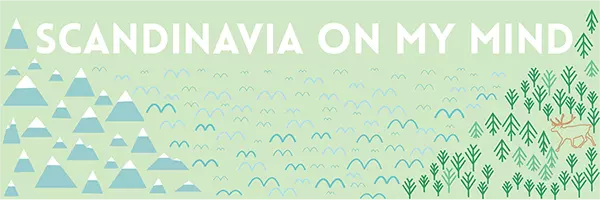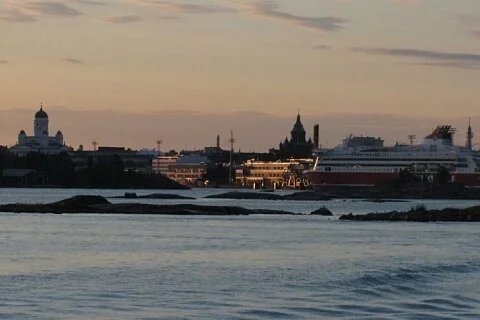If you haven’t heard of Trapped, (or Ófærð in Icelandic) then don’t worry: it’s more than likely on its way to you already.
The new Icelandic crime series has screened on the BBC, in France and distribution rights have now been sold to the US. Yep, it seems like our hunger for The Killing is far from sated.
Information on the show is somewhat scarce, or maybe I’m just too scared to dig deeper for fear of someone annoying writer giving away all the spoilers. Attempts to watch it online have so far proved futile – especially seeing as though I can’t speak French, but the general gist is that a man’s body is discovered in the fjord in a remote, unnamed town. Putting a Scandinavian twist on the Agatha Christie closed-room scenario, bad weather blocks off the town meaning that residents – and the killer – are, well … trapped.
It’s a feeling I know all too well, having stayed in Seyðisfjörður, where some of the show was filmed, in the winter last year. Here’s what I found (spoiler: there are no dead bodies).
Day One:
It is 8 a.m. and I am sitting in a bus with 10 complete strangers, who are not strangers to one another. Beyond the shape of their shadows, there is almost nothing else I can see; all else is darkness. The driver waits for a few seconds, then turns the key.
The bus, now full, makes its way onto the road. Three days ago, I wondered if I would even make it this far.
***
If you search for Egilsstaðir, the first thing you will find is that there is nothing there. Even the holier-than-thou travel bible, Lonely Planet, which loves to champion the underdog, points out that: “However much you strain to discover some underlying charm, Egilsstaðir isn’t a ravishing beauty.”
The new central hub of Iceland’s east is the only airport in the country which I have not yet visited, mostly because of the reasons already mentioned. Keen to see a new part of this country that keeps drawing me back, I found the small village of Seyðisfjörður, populated by only 700 people. That’s 100 more than the town where I grew up.
“Quirky, Charming, Fun, Funky, Lively, Lovely, Different, Friendly and Creative” are just half of the adjectives used to describe the village which has an art school drawings artists from around the world and a ferry service connecting Iceland to the rest of Europe. It is also one of Lonely Planet’s “top picks” in Iceland. Without a car, the only way of reaching it was a 30-minute bus ride from Egilsstaðir airport.
A dark day in Seyðisfjörður. (Photo by Mitchell Jordan)
After one pinkish evening in Reykjavik, I was not prepared for how dark it is here, and how dark it stays for so long. When the bus driver dropped me at my accommodation in Seyðisfjörður I felt like I was stumbling my way through a cave, weighed down by my suitcase and heavy snow.
“Does it get lighter?” I asked the owner of the hotel.
“The sun hasn’t risen yet,” she said, “but this is winter in Iceland.”
In either shock or denial, I drank two hot chocolates in quick succession, perhaps the most uncharacteristic thing I have ever done since leaving Australia because I never, ever drink anything that is hot except for gluhwein.
In my room, I look outside and don’t see anything apart from a snowy grey backdrop. The sun is set to rise in just under two hours. I close my eyes, telling myself that there is nothing else I can do until then. I don’t want to think about the reality of what I have done, taking myself off to the edge of nowhere for three whole nights. Sleep snatches me fast as an eagle and I let myself be embraced by its talons.
***
“Tomorrow, we’ll have sun.”
The older Spanish woman sitting outside the hotel smoking a cigarette looks at me hopefully when I return from a trip to the grocery store. I find it hard to believe her prediction. I can see the faintest scratch in the brooding grey sky letting through a trickle of light that disappears as fast as it arrives.
Her and her partner live here and work in a fishing factory. When she learns I am Australian her voices strains in sympathy: how am I possibly surviving this weather?
“Is hard for me too,” she says, pointing out that she comes from Seville, where temperatures reach 50 in the summer.
“Next week I go back for a holiday.”
When I say that yes, three days might be hard, she shows the true Spanish optimism and points to the snow falling before us, and the mountain slowly emerging in the background.
“But we get to see this,” she points out.
And it’s true. Part of what I wanted was to experience an Iceland outside of tourist attractions, a local village. Besides, snow remains a novelty for anyone from Sydney no matter how long you’ve been living overseas. I look at what is surrounding me. It is like we are living in a snow dome. Beautiful to look at, but frightening to be inside something so small, something that can be tipped upside down and shaken so violently.
Day Two:
The water is a metallic blue and there is nothing else I can say or think other than: this is beautiful.
Known simply as the Blue Church, this is also the venue for the town’s summer concerts. (Photo by Mitchell Jordan)
I am walking along the fjord and the sun is gleaming. It seems ridiculous that I could have ever doubted the Spanish lodger when Seyðisfjörður bears no resemblance at all to yesterday. It only takes a few minutes to get out of the “town” with one main road and small clusters of houses around it. Here, I could be the only person on earth and for some time it is only me and the reindeer I see ahead until I notice an older woman and her dog some distance behind me. The dog leaps forward as if it is appreciative of the weather and chance to be outside, but its enthusiasm for the outdoors also means it chases and scares away the reindeer.
The woman catches up and we smile. I ask her the dog of her name, and she tells me a word starting with ‘K’ that means “Black” in Icelandic. When I return home to document our interaction I find only one Icelandic word for “Black” and it begins with ‘S’.
The black dog runs, leaps through the snow like a hunter except that he’s far from fierce and has the playfulness of an adolescent.
We walk together, talk a little bit.
“Do you get lonely here?” I ask her.
“No,” she answers sincerely. “The people are very friendly.”
I’ve never found Icelandic people as strikingly gregarious as other Scandinavians but later in the afternoon I pass an older man walking with an expensive Canon camera who I assume must be a tourist. He waves and smiles like I am a long-lost friend and begins a conversation with me, telling me how he is on his way to visit his grandson and shows me some of the photos he has taken.
“It’s a pleasure to have you in our town!” he beams.
Day Three:
Sure, Seyðisfjörður has its attractions: there is a sound sculpture in the hills, and there are mountains to hike. I wouldn’t mind betting than in months there will be walking tours for those wanting the true Trapped experience. But, during my stay, almost every possible thing that can or should be done was pretty much inaccessible in the winter because of the snow. Yes, in a sense, I was trapped.
Walking becomes how I pass my time here. I walk and I walk, think and think and sometimes I don’t think at all. In my mind I have stories I have been thinking up for so long, characters and ideas that make me laugh. I think about the murder mystery story I have been writing for most of this year and plan out an entire trilogy, completely unaware that I am in the setting of one more famous than I could ever devise.
Part of me is nervous when I take the bus back to Egilsstaðir early on Monday morning. I am simply relieved that wild weather has not kept me confined here as it did to much of the country only one week earlier, and I am a little nervous, too, about entering anywhere else because it will all seem so large and busy in comparison. But I know I must leave. It’s not that I’m sad to go, or that I regret coming. It’s just that I’ve done what I needed to do. And, in Seyðisfjörður, that seems like the right way of going about things.


Leave a Reply